Oddball fashions chip chip chip away at our resistance to new ideas; how else did we get from powdered wigs to jeans and Ts, writes Janice Breen Burns. (Allow 10 minutes read time. This story first appeared in Nine Media’s Spectrum section, The Age/Sydney Morning Herald.)
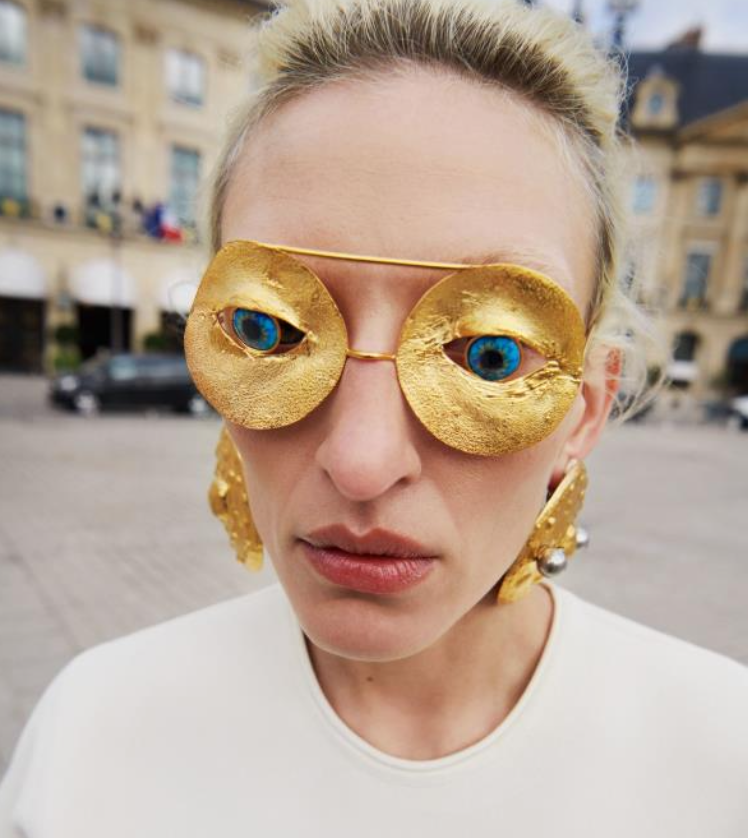
Weird fashions get such a hammering, particularly on social media. “Pointless”, “Nope” and “Where would you wear it?” are pretty typical among comments on any post with, say, an oddball Iris van Herpen, a strange Schiaparelli or anything, really, on a Rick Owens runway. There’s also a doctorate’s worth of theories why so many scoffers and trolls are genuinely angered by offbeat and “conceptual” clothes: “Bahaha!! F*&#@ing Stupid!!”, for example. There’s measurable levels of loathing for fashion in those !!!s.
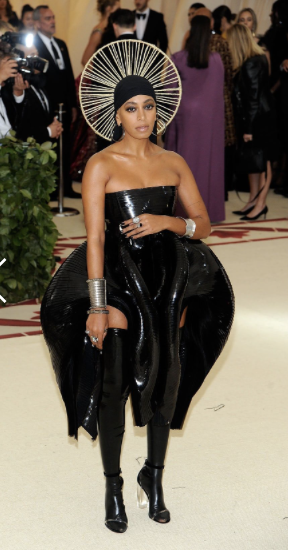
Vogue legend Ann Wintour once observed some of us feel threatened by fashion. We feel self conscious and judged and, in our deepest doubting selves, fear getting our fashion choices wrong which – stringing that theory to its rim – could mean a “nope” to being liked or, god forbid, even loved.
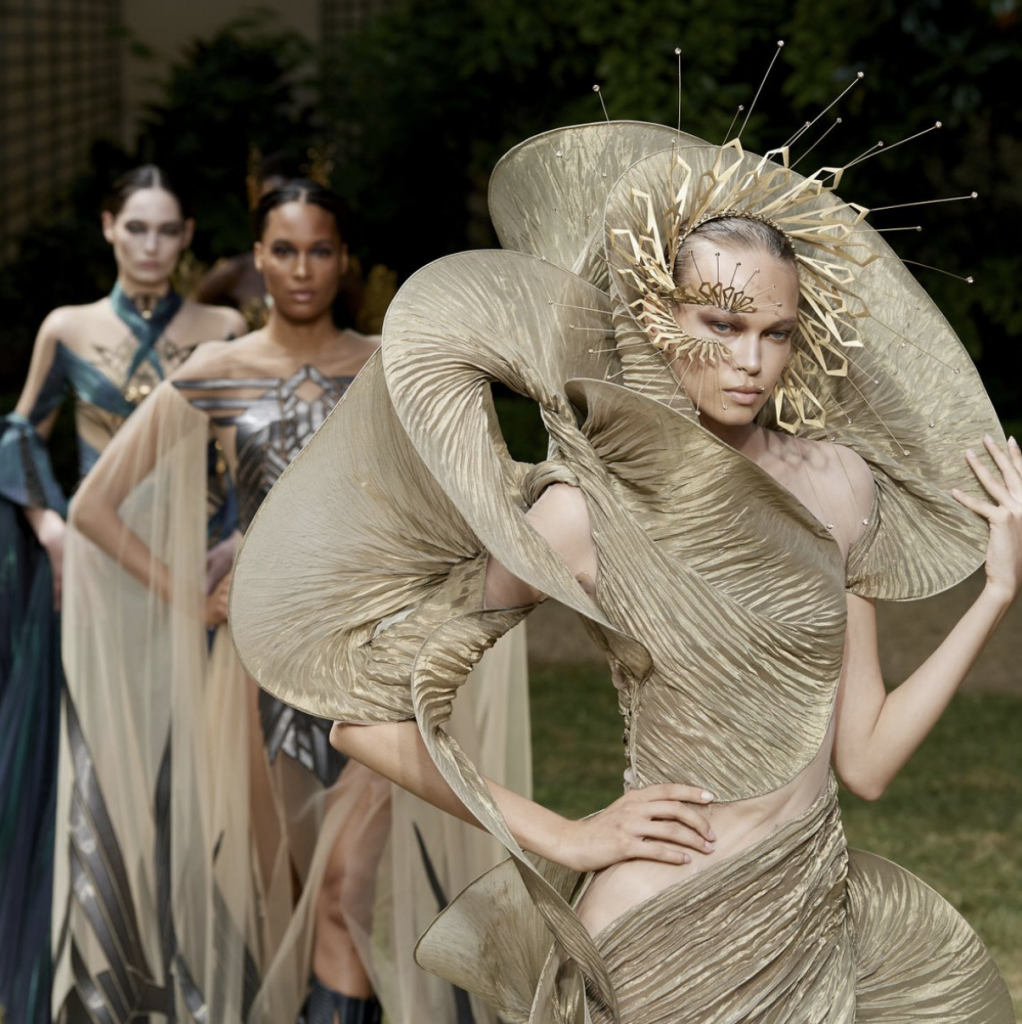
It’s all horribly complicated but, it’s also this madly human tangle of psycho-social baggage that we bring, not only to our own wardrobes but – crank that up and add steroids – to the weird stuff academics and fashionistocrats charitably call “ideas-driven” fashion.
“If you’re walking into an exhibition, or you’re seeing some outlandish, extremely artistic thing being worn at an awards ceremony by a celebrity you like,” explains associate professor Dr. Lauren Rosewarne of the University of Melbourne, “Remember you’re going to bring a different set of judgements to that than something you might see in Kmart.”
Which brings us neatly back to Schiaparelli and Iris van Herpen and their spots in the National Gallery of Victoria’s sprawling multi-floor Triennial exhibition, opening next week.
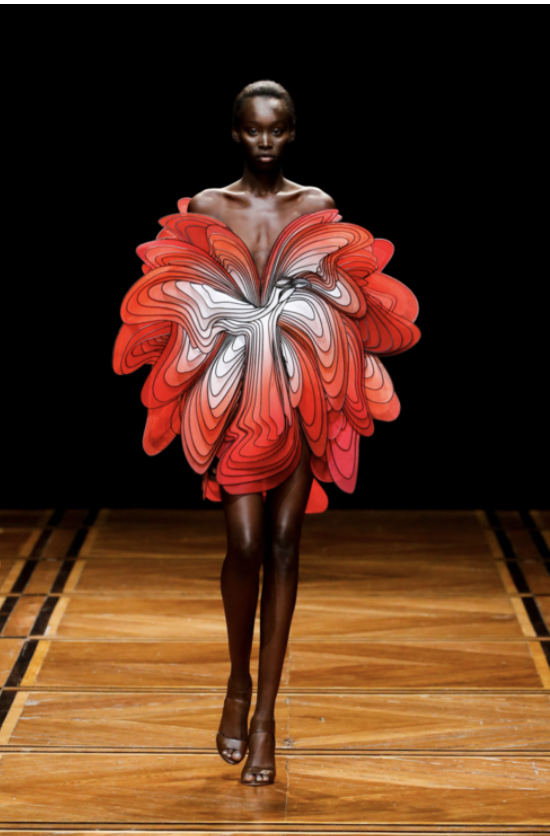
The Schiaparelli group of 20-odd surrealist-inspired accessories and gowns is by American designer Daniel Roseberry, current creative director. His tether to the mythically visionary Elsa Schiaparelli who established her legacy fashion house almost a century ago in Paris is obvious.
Schiaparelli’s offbeat aesthetic and collaborations with artists Salvador Dali, Jean Cocteau, Man Ray and others echo in spatters of celestial iconography and the elegant body bits strewn across Roseberry’s collection.
He’s cast eyes, noses and lips into gold jewels and spectacles, for example, and disturbingly witchy fingers and toe extensions. A golden face mask requires the wearer to bite into it to keep it in place, and a – whaaaaat!? – a “brooch” features full-sized maternal breast with feeding golden baby attached.
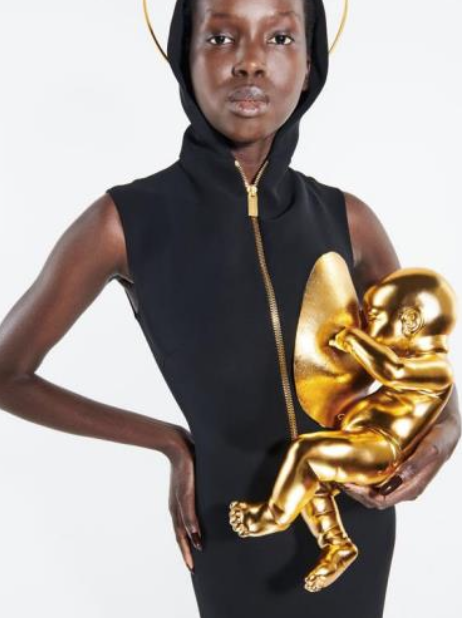
Roseberry’s work also resonates with his “celebrity darling” status, a golden goal since he joined the house from quirky US brand Thom Browne in 2019. He’s dressed a red carpet procession of A-listers from Beyonce to Lady Gaga to a queue of Kadashians.
In the Triennial’s celestial-themed Schiaparelli room, lean in to the shimmering, thickly beaded gold mini gown Beyonce wore for Vogue, for example; it’s a miracle of haute couture craftsmanship. And the black silk coat from his Une Ere de Discipline S/S 2022 collection; sharply schlooped into legendary actress Gillian Anderson’s waistline by a cunning arrangement of gored panels – not corsetry as you might expect – but with a heavily embroidered and gold embellished “ghost corset” sewn into its front.
Rising above both is “Transformations”, a spectacular piece from Roseberry’s autumn/winter 2019 show that appears to bank metres into the air of its own accord like cumulus nimbus storm clouds in summer.
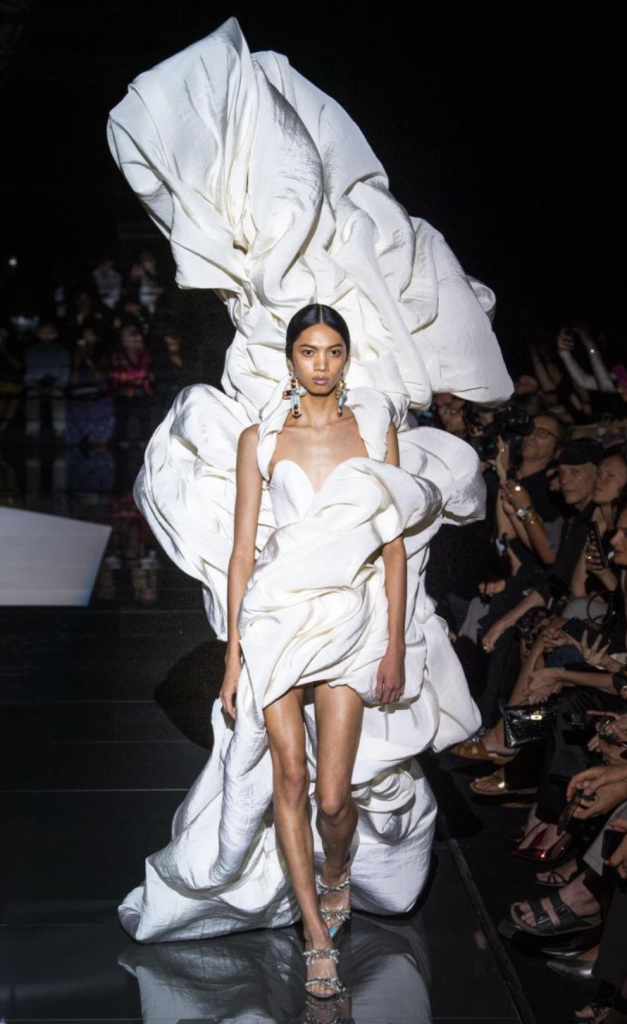
The enigmatic Dutch designer, Iris van Herpen’s exhibit, “Ananda-Maya – Look 14” is from her autumn/winter 22/23 Meta Morphism collection. She created it in all-white materials with a central spindly carapace of twisting, thickly embroidered synthetic ribs anchoring tendrils of stiffened mesh that appear to roil and swirl like smoke around the mannequin’s body. Matching 3D printed platform shoes are spiky and white as bleached coral.
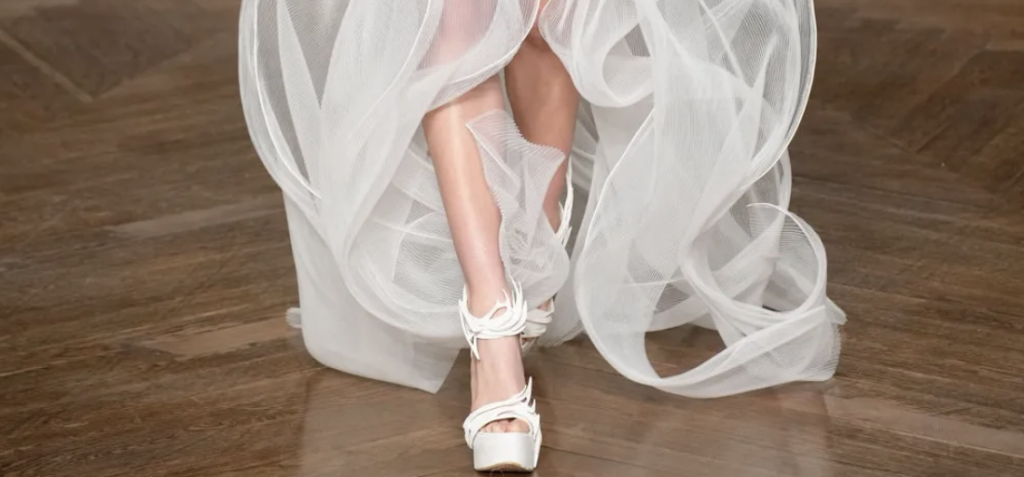
Their beauty is strange and, obviously, utterly impractical; “How would you sit in that,” was overheard at van Herpen’s haute couture show. Only the right-sized celebrity heading up the right red carpet or the most intellectually engaged of her haute couture clients with a lazy $AU100,000 (I’m guessing) could possibly give Ananda-Maya, or almost any other van Herpen, a fair crack at practical use as – what it theoretically is – a fashion garment. An item of clothing, in other words. Bahahaha!! indeed.
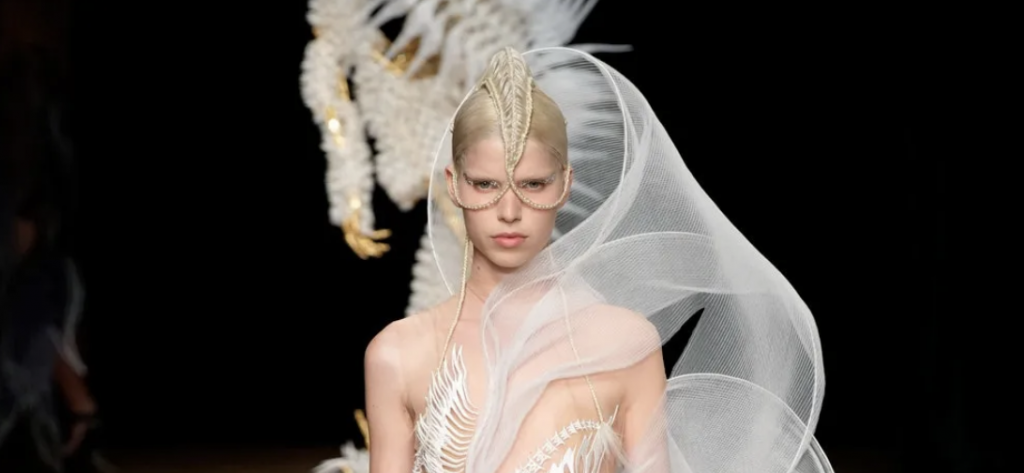
On a video call with van Herpen, 39, from her Amsterdam atelier, she ranges across all the ways that mystifying fashions like hers and Schiaparelli’s might be, if not understood then at least accepted with less angst, by mere mortals (ie: non-fashiony types).
“Even if it’s difficult for someone to consciously understand the concepts,” van Herpen muses, “Even if they’re not familiar with the inspirations behind it, and if they don’t know me, haven’t read a single interview about me, the (designs) are strong enough…that they can still feel and translate on an emotional level…”
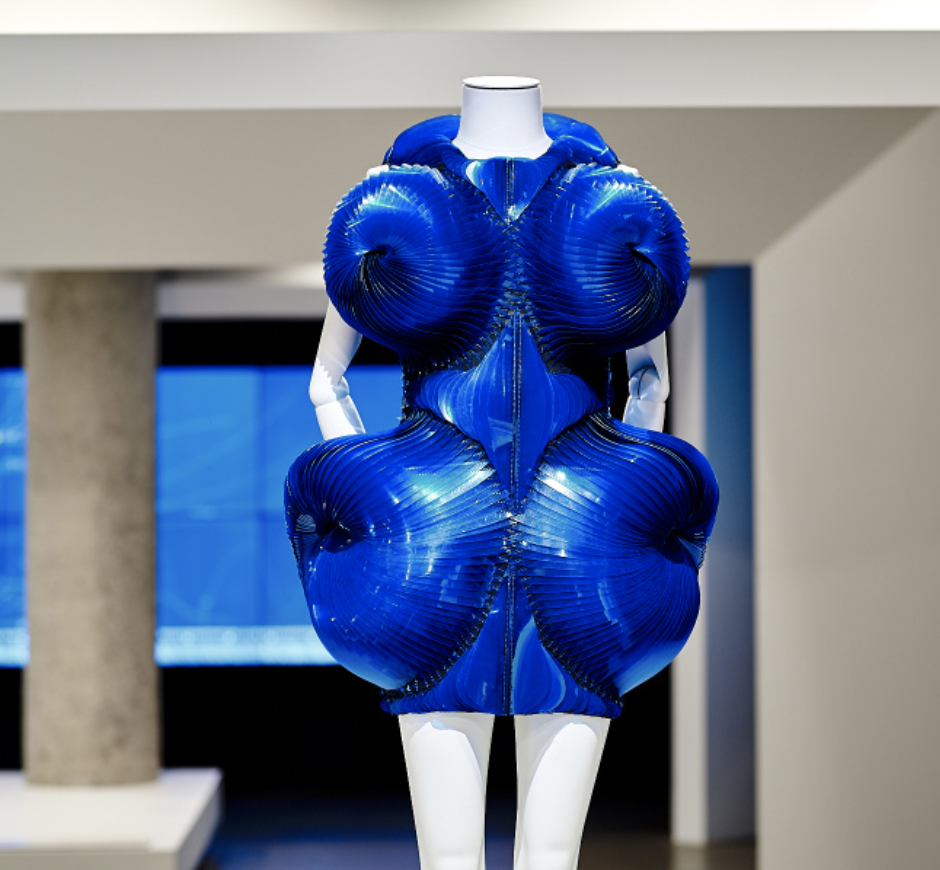
Van Herpen’s pale, clean face looms, ethereal as a Renaissance madonna’s, loosely framed by long unstyled hair, out of the fogged-out Zoom backdrop. She’s soft-spoken, precise, quick to smile, immediately likeable.
We talk about open minds, gut feelings (the best tools to observe baffling fashions), and how marvellous it is when certain celebrities on red carpets and runways act as “bridges” or “conduits” between the aghast public and some of her wackiest (my word, not hers) iterations and out-there ideas.
“Their braveness and energy brings my work to life,” she says of Lady Gaga, Bjork, Zoe Kravitz and the many other “brave women” celebrities who have, at one time or another, ignored the scoffers and trolls and gratefully agreed to be buckled, clamped, stitched, fused, heat-bonded or moulded into the latest van Herpen.
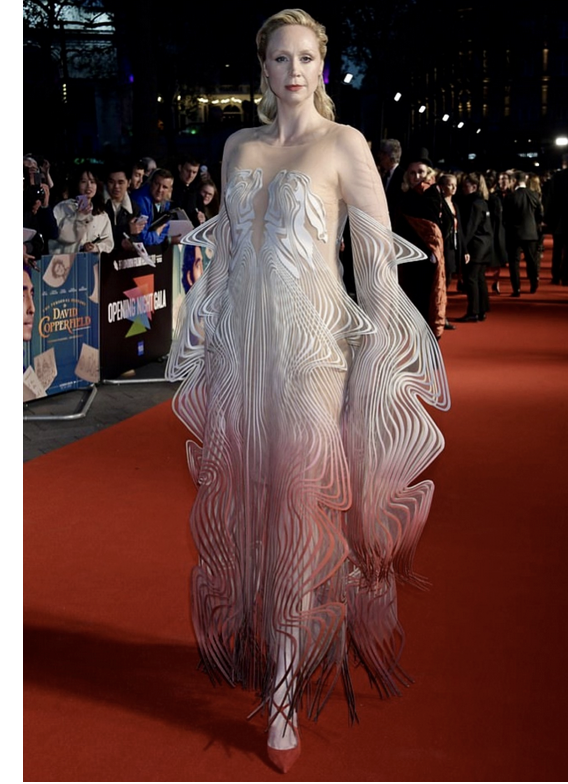
The actress Gwendoline Christie, for example, (Lady Brienne of Tarth in Game of Thrones, for those who don’t know), once described climbing into a van Herpen; “…As though you were being bound up in the technology of what it is to be alive.”
Van Herpen and I also talk about how fashion can serenely intersect art and how, in woke-speak, exhibitions like the NGV’s Triennial can offer a “safe space” for minds to open and gut feelings to blossom around weird-looking outfits.
Both artist and global fashion’s most revered maverick, van Herpen says she gets mildly annoyed by the question journalists ask most often (albeit, not me); “Are you an artist or a fashion designer?”.
“I would not know why you have to choose,” she says. “It can easily be both. In history it was common for an artist to be also, for example, a scientist, but nowadays people really want to understand which box you are in….”
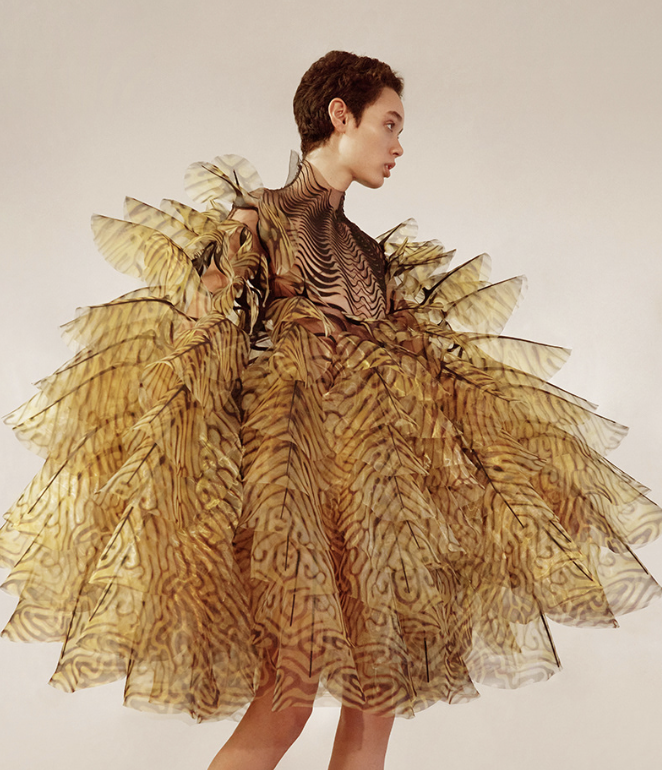
There is no box to house van Herpen. Up to 18 mind-blowing designs a season emerge from her atelier and the all-engrossing insomnia-causing collaborations she nurtures with physicists, biologists, academics, technicians, artists, architects, musicians, choreographers, filmmakers, milliners..(the list is long and goes on). “I wake up at night,” she smiles, “It’s very annoying…”
She fuses couture craft with technologies, often in airy designs that might bristle and shimmer or flicker and whirr, or “breathe” or make noise at a model’s touch, or roll and tumble as she moves or trick the eye with optical illusions or strum heartstrings for no explicable reason.
They’re laboriously invented by trial and error, micro-success and micro-failure, and since 2011, shown at Paris Haute Couture Week. She was invited onto the coveted schedule by the Chambre Syndicale de la Haute Couture when her eponymous label was just six years old.
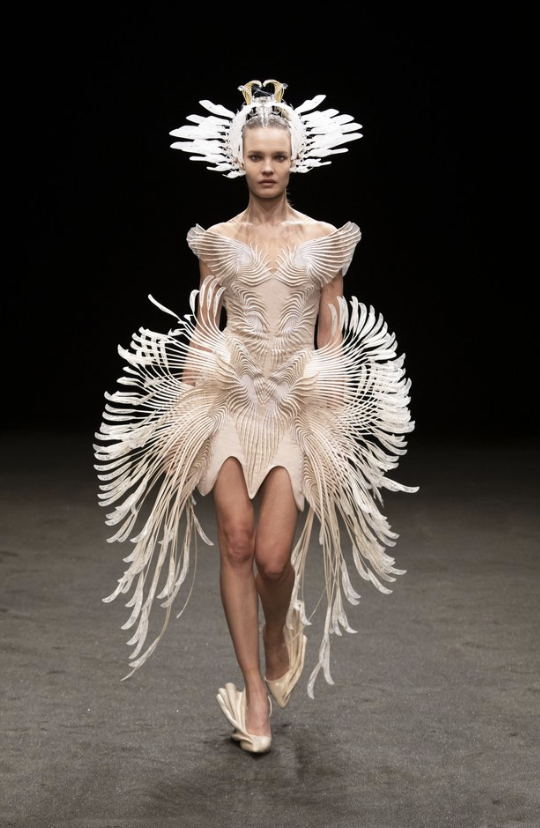
Van Herpen was the first designer to investigate 3D printing and hand-casting. And she laser-cuts, blow-torches, shreds, fuses, moulds, creates here-to-for-un-thought-of materials. Her designs are as fastidiously crafted as any petite mains haute process but with mylar, acrylics, silicone, micro-fibre, bio-materials, computer generated waves.
She experiments with electricity, sound, water, anti-matter, magnetic fields. Once, she and Belgian artist Lawrence Malstaff shrink-wrapped models into clear plastic envelopes and suspended them from the ceiling. Post-show she was shrink-wrapped herself. Another show featured a Danish ensemble of musicians and singers, Between Music, performing underwater, in tanks spaced along her runway.
Van Herpen’s designs invariably end up in museums and galleries more often than wardrobes. No surprise there. The point of their pointlessness as fashion designs is their payload of ideas, everything from cultural diversity to the knock-on effects of climate change, salty and snapping fresh from the Zeitgeist.
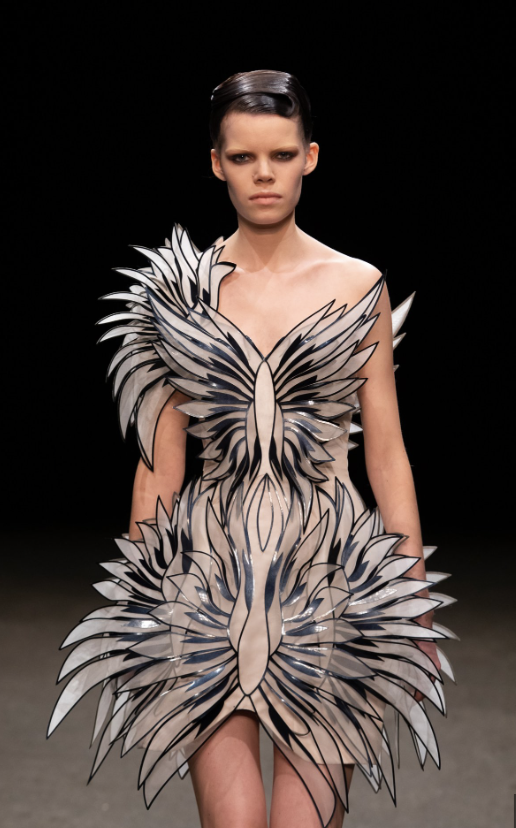
“But definitely my own personal Zeitgeist,” she corrects. Van Herpen is at pains to explain her criteria for new projects does not include the Zeitgeist’s blips, fads and flashes-in-the-pan. “I’m always looking for timelessness…” she says. “For example a concept like aquatic architecture – I’m interested in this now – will be going through an evolution in the coming 50 years….” The theory goes, her most recent collection, Architectonics, shown in Paris in July will be relevant and still sparking for the same period.
Arcing across all van Herpen’s work is her constant experiment with fashion’s core tenets, especially its traditional notions of femininity and beauty. “The exploration of femininity is really key to everything I do,” she says. “My way of working is always to be exploring different perspectives of beauty. I think of everything in motion and the concept of beauty as not solid…it can be dynamic….especially in fashion, it’s a global system so it’s very easy to get stuck in this one perception of what is beautiful…”
And her designs are unarguably, beautiful, but in unexpected ways. Ananda-Maya for example, may indeed be an exquisitely hand-crafted high-tech haute couture ode to experimental materials and the human struggle with self realisation in a world of merging digital and physical identities (feel free to jot that down), but it is also gut-punchingly gorgeous.
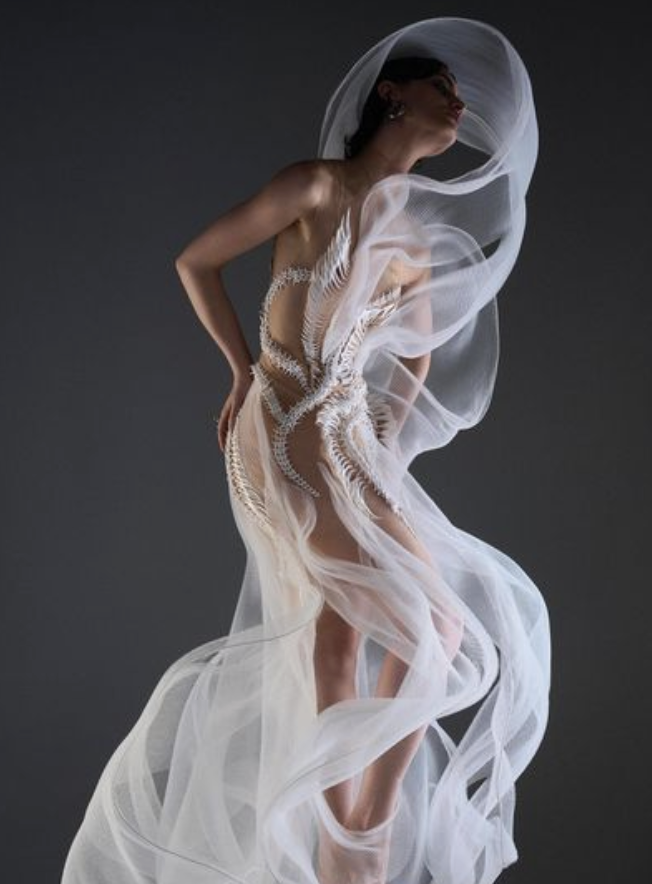
So, gloriously stupid, or simply glorious? It depends which side of the fashion divide you land after looking closely and, hopefully, reading the exhibit’s plaque and weighing all you now know about Van Herpen with that tangle of psycho-social baggage mentioned earlier.
Fashion and textiles curator Katie Somerville equates van Herpen, Daniel Roseberry of Schiaparelli and other “brave minds” like theirs, to fashion’s equivalent of a Research and Development department. “Like any field or industry, you’ve got this laboratory of ideas,” she says. “It’s those exciting, brave minds that want to explore things that haven’t been played with before…”
Somerville’s trick as a curator is to track and trap those brave minds among fashion’s millions. “It’s about picking that moment and that collection and that work…”
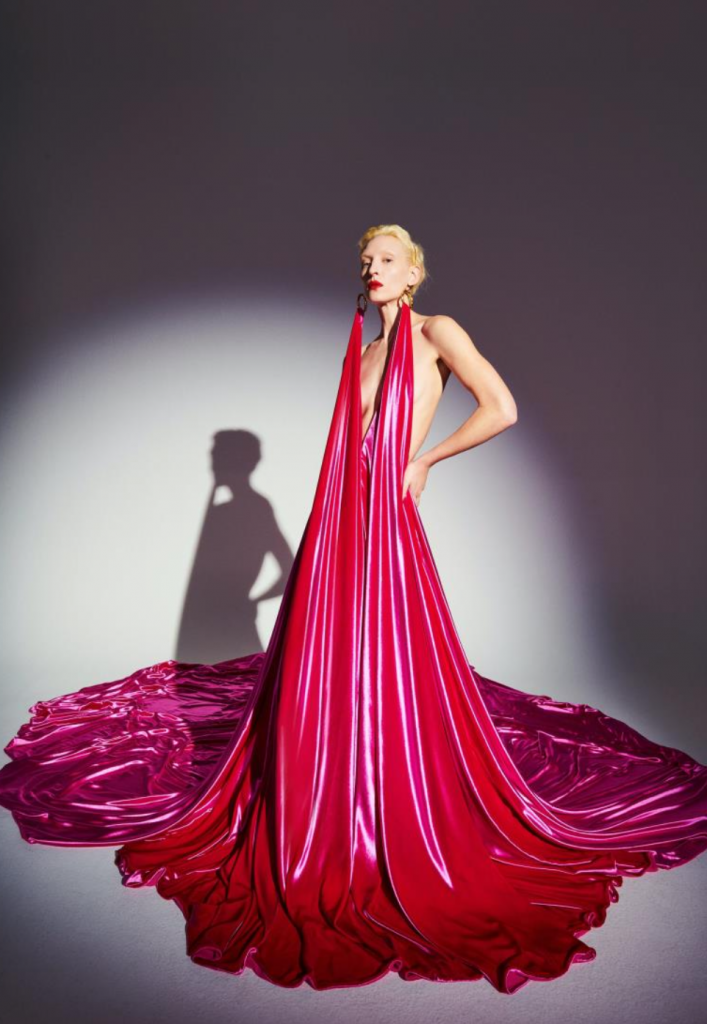
Between them, Somerville and co-curator in the NGV Fashion and Textiles department, Danielle Whitfield, have clocked 50 years’ acquiring these disruptive designs that ping in the Zeitgeist, mark their moment in history and, one way or another, push fashion’s slow, messy, back-and-forth process of evolution forward by a whisker or six.
“I guess it’s almost instinctive,” Somerville says of the complicated mechanics, “But you do build up a visual bank (of fashion) in your head….”
If you’re puzzled at this point by what exactly fashion evolution is, use the “powdered wig” inquiry for enlightenment. Across centuries of (European) civilisation, how did we get from primitive skins, to medieval hop-sack, to Rococo crinolines and powdered wigs, to modern micro frocklets and jeans n’ T’s?
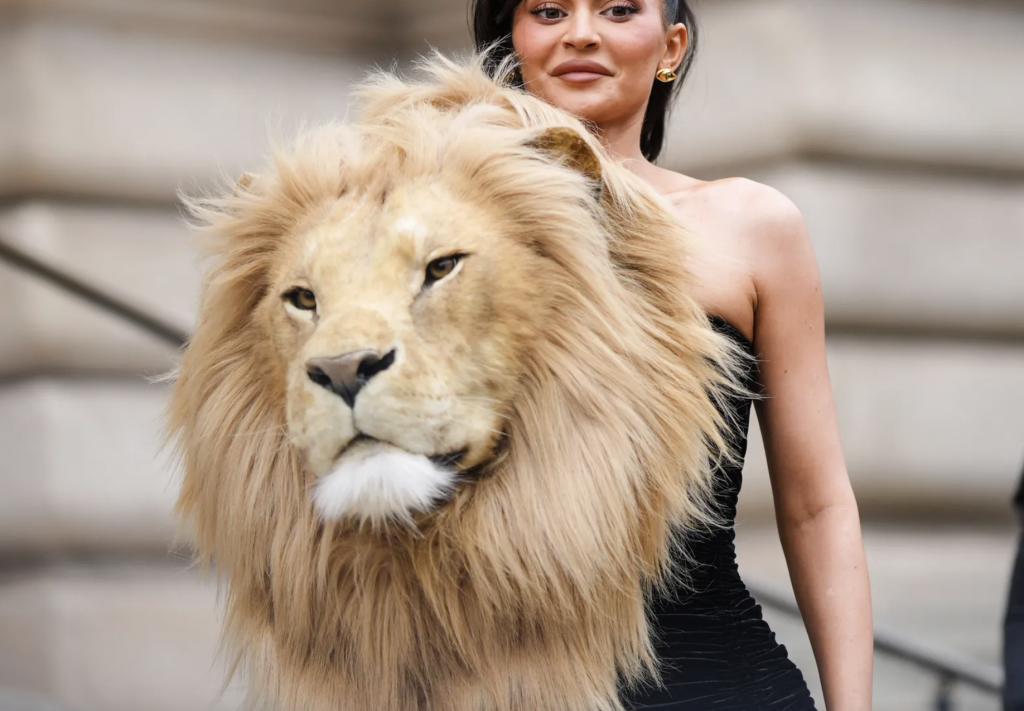
Chip, chip, chip is the answer. “There’ll be some element, some small gesture that people will absorb,” says Somerville of the NGV’s apparently baffling exhibits. “It might be a colour palette, a material, accessories…but it’s something they’ll feel comfortable adopting themselves when they feel creative…”
“Or it could be feathers or certain prints,” adds Rosewarne. “Without fully understanding that that outfit, intact, is not actually ever going to be sold to you, it might take quite a while but bits of it, details, will end up at your local shopping centre….”

And so fashion evolves: disruptors disrupt, hardened fashionistocrats, plucky celebrities and adventurous dressers snub the scoffers to adapt their designs and make them their own, a pall of public acceptance descends, more people wear the weird and more and – voila – ideas once considered glorious stupid are slowly normalised.
Just glorious.
AND ALSO:
Triennial is open at the NGV until April 7, 2024. Exhibits include 75 projects “at the forefront of global contemporary practice” by 100 artists, designers and collectives. Admission is free.
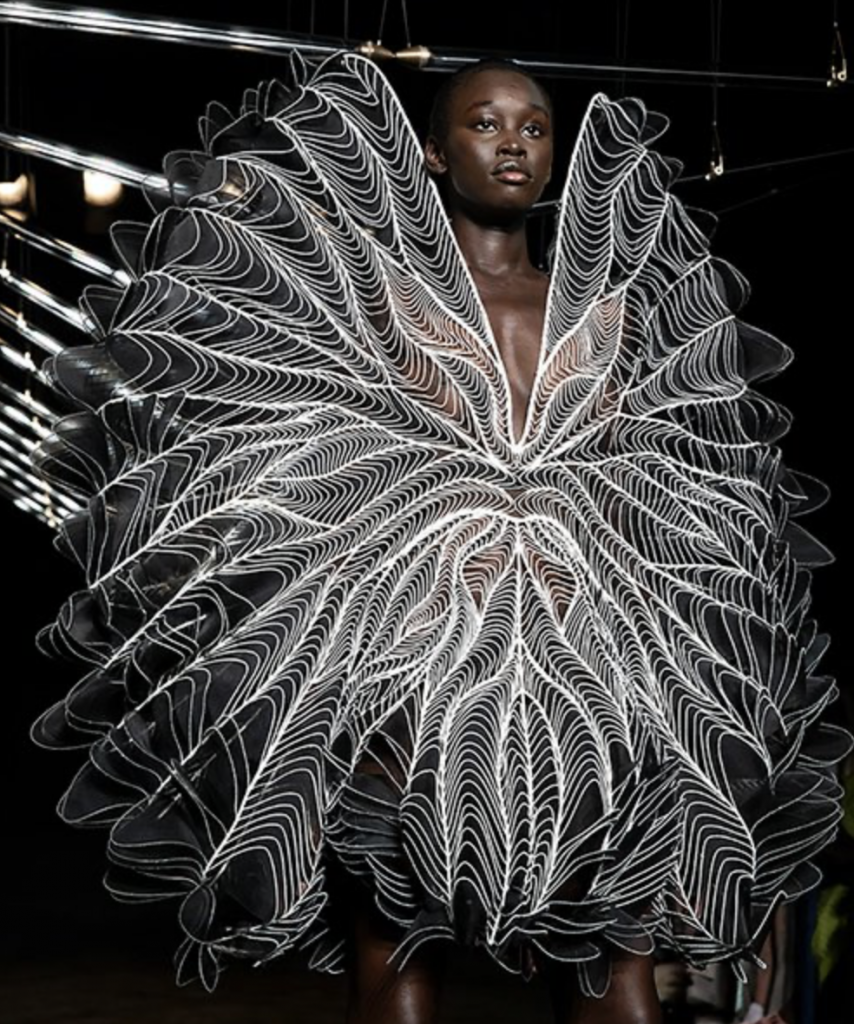
Iris van Herpen is celebrating 16 years of her eponymous label with a colossal retrospective exhibition, “Iris van Herpen: Sculpting the Senses‘ at Paris’s Musée des Arts Décoratifs opened by Queen Maxima of the Netherlands. After its close in April 28, 2024, the exhibition will be shipped to Brisbane for a season at QAGOMA from June 29 to October 7.
/





